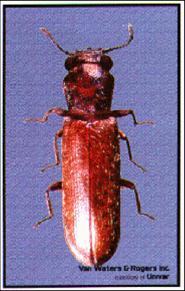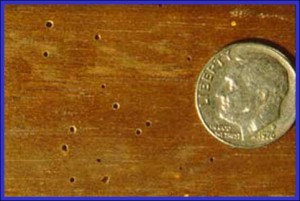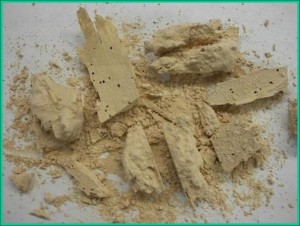
Powderpost beetles
Powderpost beetles
The term powderpost beetle refers to several species of wood-destroying beetles that belong to three different families of beetles (Lyctidae, Bostrichidae and Anobiidae). Their common name is derived from their fine, powdery frass (excrement) that accumulates under infested wood. Powderpost beetles are second only to termites in their ability to destroy wood in structures and furniture. They are capable of re-infesting dry, seasoned wood year after year. The interior of the wood that is repeatedly attacked is completely riddled with holes and galleries packed with the powdery frass. Powderpost beetles can infest any untreated or non-sealed wood article. Some species only attack hardwoods, while others feed only on softwoods, and some species will feed on both. Under normal conditions, powderpost beetles require about a year to complete their development. However, if the wood has a high moisture and starch content, development may be completed in 6 months. The moisture content of the wood is a very important factor in managing powderpost beetles. Wood should be maintained below 20% moisture content to reduce its suitability to powderpost beetles. Some experts believe if the wood is kept dry enough, then no insecticide application is necessary.
Powderpost beetles can also be controlled by sealing the surface of the wood with shellac, paint or varnish which discourages female powderpost beetles from laying eggs on these surfaces. Chemical control of powderpost beetles includes three options. Fumigation with a penetrating gas (methyl bromide) is the most effective means of chemical control but it is also the most expensive, and in most cases, prohibitedly so. Fumigants are the most dangerous type of insecticide and can only be applied by a professional applicator with special certification.
Insecticide sprays applied to wood surfaces are also effective in controlling powderpost beetles. Tempo (cyfluthrin) and two borate products called Bora-Care and Tim-Bor are the only registered insecticide sprays that can be used in occupied structures. Borates can be applied at anytime, but two applications are required to provide effective control. Borates must penetrate the wood to be effective, therefore, it should not be used when the wood to be treated has been painted or sealed with polyurethane.
Tempo (cyfluthrin) is also available under the brand name Bayer Advanced Garden Insect Control or Bayer Advanced Home Insect Control. It must be applied just before the adult beetles emerge in late spring to be effective. Tempo should be applied in mid-May and again around the first of August. Eye goggles are a must when treating for powderpost beetles since you will be spraying areas above your eyes. Provide good ventilation when applying any insecticide indoors. Be sure to read and follow all the instructions and safety precautions found on the pesticide label before using any pesticide.






 Print
Print Email
Email




